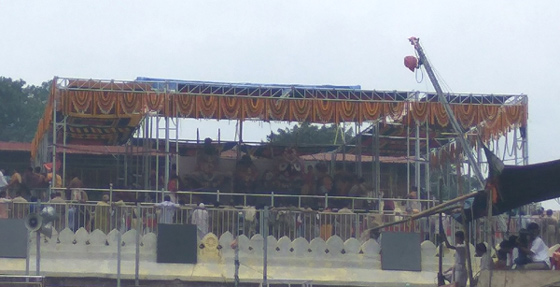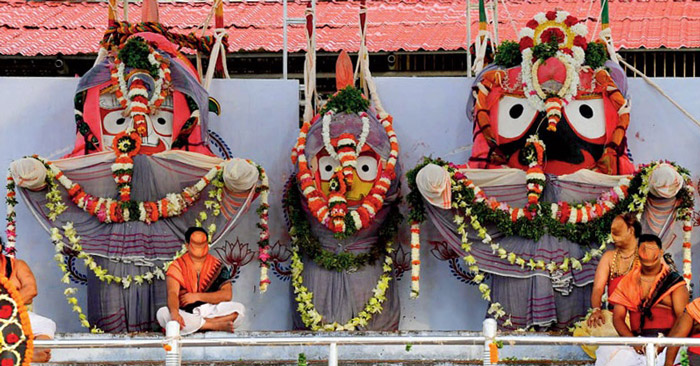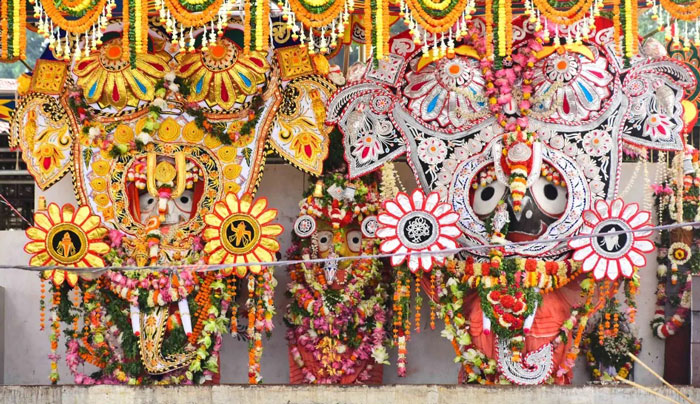

Loading Section...
A very special and sacred festival of Lord Jagannath held in the full-moon day of the month of Jyestha (June-July). This festival is known as 'Devasnana Purnima' or 'Snana Yatra' or 'Devasnana Yatra' (Bathing Festival). There is a general belief that the devotee washes away all his sins if he gets a vision of the Lord on this day, therefore, it attracts thousands of pilgrims from all over the world. According to Skanda Purana when King Indradyumna installed the wooden deities he arranged this bathing ceremony. On the morning of Snana Yatra, the idols of Lord Jagannath, Lord Balabhadra and Goddess Subhadra along with Lord Sudarshana are ceremonially brought out from the Garbha Griha (inner sanctum) of the main temple in a procession (called 'Pahandi' in local language) to the bathing pandal.






The bathing pandal is known as 'Snana Mandapa' or 'Snana Bedi'. This bathing platform is situated to the north-east of Ananda Bazar and besides the outer wall of the temple (called Meghanada Pacheri in local language).The length and breadth of this bathing platform is 76 feet. It is at such a height that visitors standing outside the temple also get a clear view of the Deities.



On this auspicious day the Suaras and Mahasuaras go in a ceremonial procession to fetch 108 pots of water from the Golden well (called 'Suna Kua' in local language) located near the northern gate of the temple. The holy water drawn from this well once a year. During the entire process all of them cover their mouths with a piece of cloth so as not to contaminate it even with their breath. Then all the pots filled with water are preserved in the Bhoga Mandap. Then the priests purify the water with haladi (turmeric), java (whole rice), chandan (sandal), flowers and perfumes. The filled and purified water pots then carried from Bhoga Mandap to the bathing platform by the Suaras in a long single line queue. This ritual is called 'Jalabhisheka'. Jalabhishek consists of two words 'Jala' and 'Abhisheka'. In local language, Jala means water and Abhishek means Bath. This Abhiseka is accompanied by chanting of vedic mantras by the priests, kirtana and blowing of conch shells.






Out of the 108 pots, 35 pots of water are poured over Lord Jagannath. Lord Balabhadra bathes with 33 pots of water, Goddess Subhadra with 22 pots of water and Lord Sudarshan is bathed with 18 pots of water.
Just like every living being searches desperately for water to beat the fury of Sun in the month of Jyestha (Jun-July), the Holy Trinity of Jagannath Temple also come out of the Ratna Singhasana (Sanctum Sanctorum) on to the Snana Mandapa (bathing platform) to receive the grandest and holiest bath to beat the heat of the Sun. But there is a big difference between the bath of humans and the Snana Yatra of Lord Jagannath. While bathing we try to be in seclusion, away from the sight of others, but the revered Deities show a different characteristic. Lord Jagannath, Lord Balabhadra, Goddess Subhadra and Lord Sudarshan enjoy their bath, out in the open, in front of their devotees, on the Snana Bedi.
At evening, after the bath ritual, the Deities assume the special elephant form which is otherwise known as 'Hati Besha' or 'Gajanan Besha' or 'Gaja Besha'.
Why Lord Jagannath took Hati Besha (Elephant Attire)?
The Lord took the Hathi Besha because he wanted to satisfy the desire of his devotee who visited Jagannath temple. In the 15th century, Pandit Ganapati Bhatt of Mahaganapatya community from Karnataka had visited Puri to have darshan of Shree Jagannath. Ganapati Bhatt was a staunch devotee of Lord Ganesh. He read Brahma Purana and could know that 'Brahma' in real form was residing at Nilagiri Sri Kshetra Puri. He decided to come Puri and to have darshan of Brahma. He reached Puri on the day of Snana Purnima. Ganapati Bhatta saw Lord Jagannath on Snana Mandap with other deities, he focussed on Lord Jagannath very keenly and was trying to see his favorite Lord Ganesha in him and was disappointed.
He left the temple and was planning to leave Puri. Lord Jagannath could know the feelings of his devotee. The Supreme Lord took the form of a Brahmana and went to Ganapati Bhatta and implored him to come and see Lord once again on Snana Mandapa before leaving Puri. He was reluctant, but the Lord persuaded him, finally he agreed and decided to visit the temple in the evening. In the evening, he came to Snana Mandapa and to his surprise, he saw Lord Jagannath in the head of elephant. He danced on the road saying that God had fulfilled his desire. From that day onwards, in the evening of Snana Purnima, Lord Jagannath is dressed as a black elephant, Lord Balabhadra as a white elephant, and Goddess Subhadra is dressed in Kumari Besha. Both black and white elephants each being a form of Lord Ganesha.
The elephant attire costumes are prepared by the artisans and sevakas at Raghaba Das matha and Gopal Tirtha matha.



After Snana Yatra, the deities are traditionally believed to fall ill (suffering from fever). At night, the deities (except Madanamohana) return to the temple in a procession and are placed on a special place called 'Anasara Pindi' or 'Anasara Ghara'. They stay away from the public view for a period of 15 days. This period is known as 'Anasara' or 'Ánabasara'. During this period, the servitors of a particular group known as 'Daitapati' perform certain Gupta (secret) Riti (ritual) of the Deities. This ritual is called 'Anasarariti'. During Anasara, the Deities offered only fruits and water mixed with cheese and Dasamula medicines to cure from fever. The Deities are treated by the Raj Vaidya (the King's physician) with specific medicines (Dasamulas). During all these 15 days the daily rites of the temple remain suspended and devotees head to the Alarnatha Temple in Bramhagiri to get a darshan of Lord Jagannath. It is believed that Lord Jagannath manifests as Lord Alarnatha during this period.
Due to the sacred bath with 108 pitchers of water, the colours painted on the Deities fade out. The Daitas repaint the Deities with new colors and on the 16th day the Deities appear in their new forms after colouration and become ready for the public view. A special rite called 'Netrastova' (festival for the eyes) or 'Nava Jaubana' (festival of the new youth) takes place on this occasion. On Pratipada Tithi (i.e. the day before the Car Festival), the deities give darshan to thousands of eager devotees which is known as 'Nava Jaubana Darshan'. From next day onwards, the annual Ratha Yatar (Car Festival) of the Deities starts.
Loading Section...
Loading Section...